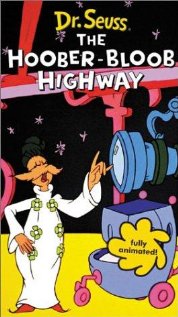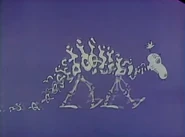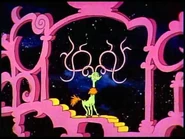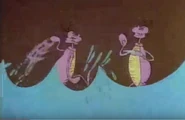
The Hoober-Bloob Highway is an animated special that aired CBS in 1975. It was the first special Dr. Seuss made for television that was not based off any of his books (despite borrowing various elements from some of Seuss' books). It's about a dispatcher of newborn children from some location in space who is trying to persuade a kid to go to earth and by the end of the special he agrees.
Plot[]
The titular highway is a long and winding road that leads to Earth from an area high up in space where newborn babies come from. The plot revolves around a newborn child, referred to as "Bub", as he tries to decide what he wants out of his life, or even if he wants to go at all, before being sent down the Hoober-Bloob Highway to be born.
Mr. Hoober-Bloob, with the help of a lute with arms and legs that often breaks into fast-paced solos (to the annoyance of Mr. Hoober-Bloob), explains to the child what to expect in human life. His explanations are often accompanied by musical vignettes of the baby, depicted as a pre-adolescent boy, in an unusual situation that accompanies the song (such as being placed in front of a long and quickly scrolling tape with checkboxes on it and being expected to check the boxes quickly in the "Answer Yes or No" segment). Eventually, the baby makes the decision to depart for the world below, and Mr. Hoober-Bloob excitedly pushes his carriage down the Hoober-Bloob Highway at last.
Voice Actors[]
- Bob Holt - Mr. Hoober-Bloob, Snail Race Announcer
- Hal Smith - Narrator (Math Teacher, Story Teller)
Trivia[]
- This the first DFE Dr. Seuss special not to have been based on any of Geisel's books. However, some elements were borrowed from or later incorporated into some of the books as follows:
- I Had Trouble in Getting to Solla Sollew:
- Mr. Hoober-Bloob is a modified version of the doorman of Solla Sollew.
- Oh Say Can You Say?:
- The lute with arms and legs was later reworked as the walking mandolin in this book.
- A skeleton creature in one scene was the inspiration for Dinn.
- There's a Wocket in My Pocket!:
- Bub as seen in the vignettes is likely a modified version of the boy from this book.
- During the scene where Bub (in the vignettes) is getting dressed, one room loosely resembles the one from page 6-7 of this book.
- Did I Ever Tell You How Lucky You Are?:
- The Town of Ga-Zair is featured in one scene.
- The way Bub (in the vignettes) made the disassembled Shnorkin into a mess is similar to Herbie Hart's Throm-dimbulator.
- The scene where Bub (in the vignettes) marks checkmarks on Yes or No questions is a reference to page 24-25 where Mr. Potter is dotting the letter i's and crossing t's.
- If I Ran the Zoo:
- Two Obsks, a flock of Wild Bippo-No-Bungus, a Tizzle-Top-Tufted Mazurka, a Big-Bug-Who-Is-Very-Surprising, Chugs, a Deer with Horns-That-Are-Just-A-Bit-Queer, a New Sort-of-a-Hen, an Elephant-Cat, and an Iota make a cameo in one scene where Mr. Hoober-Bloob shows Bub a variety of different animals.
- Some animals seen on the pre/post-pages of the book made a cameo in said scene as well.
- On Beyond Zebra!:
- A Jogg-oon, a Sneedle, a Zatz-it, a Wumbus, and a Yekko make a cameo in one scene where Mr. Hoober-Bloob shows Bub a variety of different animals.
- Scrambled Eggs Super!:
- A Stroodel makes a cameo in one scene where Mr. Hoober-Bloob shows Bub a variety of different animals.
- Oh the Thinks You Can Think!:
- Marvin K. Mooney Will You Please Go Now!:
- The Shnorkin that Bub (in the vignettes) was driving is similar to the Crunk-Car, except it's on tracks instead of legs.
- Fox in Socks:
- Tweetle Beetles and the poodle appear in one scene.
- I Had Trouble in Getting to Solla Sollew:
- While Mr. Hoober-Bloob, the Narrator and the Snail Race Announcer as well as the singing chorus are the only speaking characters, the rest of the characters including Bub (as an infant/in the vignettes) and his dog are silent.
- The boy as seen in the vignettes is generally thought of as Bub in his pre-adolescent form. However, given that the vignettes shown in the TV screen Hoober-Bloob shows to Bub could be a training video produced for the future-viewing contraption (Mr. Hoober-Bloob does say, "Roll the reel!"), and that the boy in the vignettes was meant to demonstrate what life would be like for a newborn human, it's possible the boy in the vignettes could actually be a different person and not Bub himself. There is a confusion between the two characters, because at the end of the special, a dog (identical to that one which appeared with the boy in the vignettes) is also following Bub down the Hoober-Bloob Highway while his stroller was rolling down the "highway" to Earth.
- Confusion also occurs because Hal Smith is often credited in databases as being The Narrator. The end credits refers to Hal Smith as the only credited person under "Additional Voices". Bob Holt (Mister Hoober Bloob and the Snail Race Announcer) has narration duties as well, and it is clearly Bob Holt being Mister Hoober Bloob. If Bob Holt and Hal Smith really tried hard enough, they could voice any of the characters either of them were assigned to.
- Particularly Hal Smith's voice can be heard midway in the production as the voice of the off screen Math Teacher.
- Hal Smith is also the story teller about the Tweedle Beetles.
- One of the locations that Bub is shown is Bajinajistan. It is derived from Rajasthan.
- At the time of being included on the DVD release of The Grinch Grinches the Cat in the Hat and the 2012 Deluxe Edition DVD/Blu-ray release of The Cat in the Hat, this was the only DFE Dr. Seuss special to have not been remastered in any better quality at the time unlike the rest of the specials, instead being remastered from its original broadcast in low audiovisual quality. Its picture and sound were not genuinely restored until it got a high definition remaster for its exclusive inclusion in streaming releases of The Cat in the Hat.
- Although the special is still in marketing circulation, one shot during the song Things You Have to Know featured Ching-Chong-Chose, which appears to be a negative depiction of Chinese people and culture (six of Dr. Seuss’ books, including some of which this special borrowed elements from, were banned for these ethnic subjects since March 2021).
Production notes[]
- This is the last Dr. Seuss special to be aired on CBS.
- This is the last special to be produced by Cat in the Hat Productions and to feature the Cat in the Hat Productions logo. However, the logo only appears at the end of the credits in this special.
- This is the next to last special to have Friz Freleng credited as producer instead of Executive Producer. He would appear as such again for The Grinch Grinches the Cat in the Hat at the same time with Ted Geisel.
- This is the final time that Friz Freleng, credited as producer, appears in a slide of his own.
- This is the final time that Friz Freleng and Ted Geisel appear as producers separated into two individual slides.
- David H. DePatie is credited as the only Executive Producer. This is the final time he does so in this arrangement.
- For the next two specials, beginning with Halloween is Grinch Night, David H. DePatie and Friz Freleng are credited on the same slide both as executive producers. This is how they have done it since their work on Pink Panther.
- David H. DePatie returns to single Executive Producer during The Grinch Grinches the Cat in the Hat.
- There is a major change in production staff after this special. The last of Chuck Jones's production staff (from MGM Animation/Visual Arts) such as Dean Elliott and Maurice Noble did not work on any more Dr. Seuss stories.
- This is also the last Dr. Seuss special to feature music from Dean Elliott. He was replaced by Joe Raposo.
- This is the first Dr. Seuss Special to have Production Design credited to Roy Morita.
- According to the credits, this special was produced in 1974.
- Like How the Grinch Stole Christmas! and Horton Hears a Who!, this is one of the few Dr. Seuss specials whose style slightly differs from that of a usual Dr. Seuss book – most characters' eye pupils are not shiny (except half of the animals who were from the books), and the color, layouts, and backgrounds are more elaborate and abstract unlike the The Cat In The Hat, The Lorax and Dr. Seuss on the Loose whose style is more accurate to a fully colored, fully animated Dr. Seuss book.
- A similar style (minus the eye pupils) would also be in The Grinch Grinches the Cat in the Hat.
Animation/technical goofs[]
- For a brief moment in the career choice segment, one of the coat sleeves of the very long arms is colored wrong.
- During the first half of the end credits, there are two small jump cuts in-between the additional voices, backgrounds, layout and sequence director credits that caused some choppiness in the smooth vertical pan of the space background.
Reception[]
The Hoober-Bloob Highway was nominated for a Primetime Emmy, but it lost out to Yes, Virginia, There Is a Santa Claus. Today, it is one of the lesser-known Dr. Seuss animated specials, having not been a book adaptation.
Home Media[]
The Hoober-Bloob Highway was first released on VHS by Playhouse Video in 1985, in a double feature along with The Lorax. Playhouse Video also reprinted the special on VHS individually in 1989. In 1994, a sing-along version was released on VHS. On other Dr. Seuss home video releases, it was also included as a bonus special on the Dr. Seuss Classics 1998 VHS reprint of The Cat in the Hat, the 2003 VHS and DVD releases of The Grinch Grinches the Cat in the Hat, and the 2012 Blu-ray re-release of The Cat in the Hat. On February 19, 2013, the special was also released on DVD by Warner Home Video under Hats Off to Dr. Seuss: Collector's Edition, along with Pontoffel Pock, Where Are You?, The Butter Battle Book, and Daisy-Head Mayzie which were also included as bonus specials.
Soundtrack[]
The Hoober-Bloob Highway features a number of songs, centered around the decisions the newborn must make about his future life. All the lyrics are written by Dr. Seuss, all music by Dean Elliott. Some of the chorus consists of Thurl Ravenscroft and The Mellomen.
- The Hoober-Bloob Highway
- ...And That's the Way It Is, Bub
- West Watch-A-Ka-Tella
- This Is Your Life
- Among the Daisies
- That's Just the Beginning
- Things You Have to Know
- I Know the Way You Feel, Bub
- On the Other Hand, Though
- It's Fun to be a Human
- What Do You Do?
- Answer Yes or No
- You're a Human
The soundtrack was referenced by rapper Danny! through a track titled "This Is Your Life (In West Watch-A-Ka-Tella) (instrumental)" off of his album Where Is Danny? The Japanese version of this record, released via Interscope Records, replaces the aforementioned track with another instrumental titled "...And That's the Way It Is, Bub", also in reference to the soundtrack.










